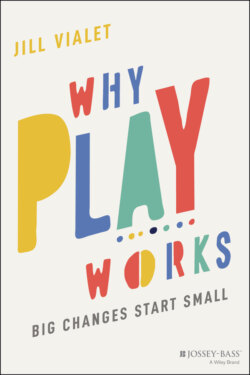Читать книгу Why Play Works - Jill Vialet - Страница 11
How to Use this Book
ОглавлениеI imagine that if you're reading this book, it's because you already have an intuition that play is far more influential than we usually acknowledge. Maybe you've had a striking play experience with your own kids—or your students or the young athletes you coach—and now you're trying to make sense of it. Maybe you're hoping to figure out how you might intentionally tap the power of play—or to convince other grown‐ups of what you've discovered. In any and all of these situations, Why Play Works is for you.
Why Play Works is organized into three main sections. It starts out with a brief exploration of the theory and the science behind the power of play and the surprisingly challenging task of actually defining play. I can imagine that some of you might be tempted to skip over this seemingly academic opening, but I'd encourage you to at least skim it. This section is really the foundation of understanding why you should care about play and provides some persuasive ideas for anyone who is trying to convince others of play's importance.
The second section, and really the heart of the book, is made up of Twenty Big Changes where play can offer a powerful small start. The book digs into the role of play in creating social norms, promoting social connection and physical activity, along with the relationship among play, safety, risk, and learning. The Playworks experience provides a great springboard for exploring play and leadership (primarily through the lens of our Junior Coach Leadership Program), and lessons learned from running sports leagues offer a chance to consider the issues of gender, competition, and the role of families. Throughout the book I've tried to illustrate how play can serve as a powerful lever of design in creating intentional teaching and learning moments. I also look at how play can work in conjunction with space and place, including the regional differences we've encountered bringing Playworks to new cities across the US, in expanding our efforts to Ireland, and most recently translating our approach to work virtually. Finally, I've included thoughts on the change that is possible through the connection between race and play, and the role of play in healing.
Each of the Twenty Big Changes has an accompanying Power of Play—insights related to how these changes show up at school—and a Small Start—a game or activity that is intended to make concrete the way that play can serve as a catalyst. I've also included a bunch of my favorite game recipes at the end of the book, and you can share those with others by sending them to the link: www.playworks.org/whyplayworksgameguide.
You'll also find a few Time‐Outs mixed in—ideas that offer slightly different ways of thinking about play, intended to spark your curiosity about the changes you might achieve.
The third and final section of Why Play Works, We Can Do This, looks at the role of adults in promoting play. This section is my call to action—an invitation to the reader to consider how you might become a more active enabler of play and the big changes it can prompt.
***
This is a critical moment in the American experiment. The polarization that defines our public discourse is extreme, and there is a pervasive sense of hopelessness about the possibility of finding common ground. This book sets out to show how play is precisely the counterintuitive solution we need at this moment. Although frequently dismissed as frivolous, nothing could be further from the truth. Play is the antidote to disconnection, isolation, fear, distrust, and despair. It can help in mitigating trauma while building the confidence and resilience essential to navigating risk. It is a source of joy that facilitates understanding across difference. It taps our intrinsic motivation, teaches us to deal with the unexpected, and sparks creativity. Play is where we learn the changemaking skills—the everyday, inclusive leadership skills—that this moment so desperately requires. With this book, I invite you to suspend your disbelief and to consider how play might work for you, your community, and our democracy.
